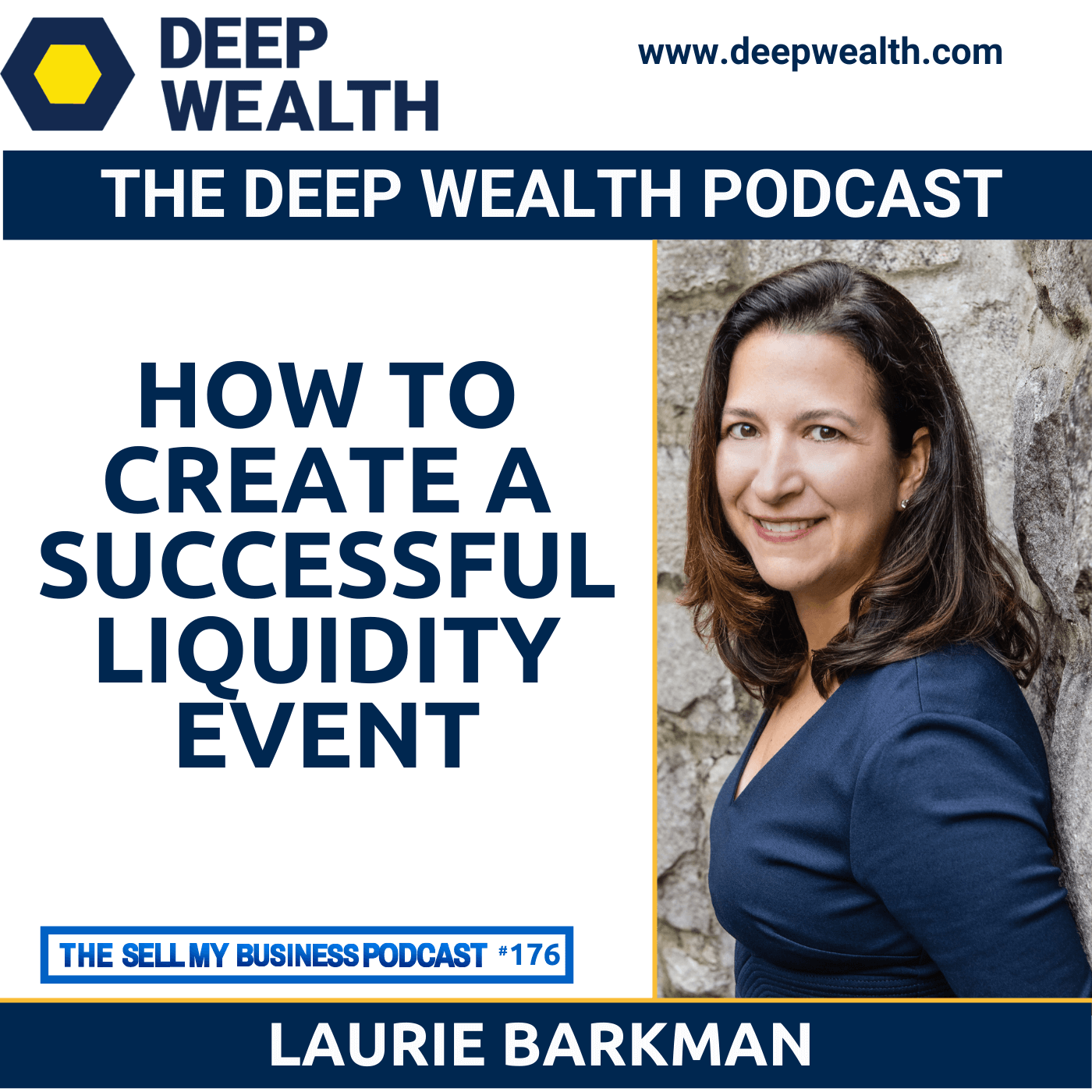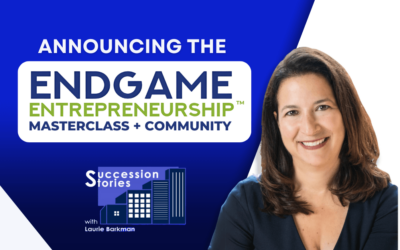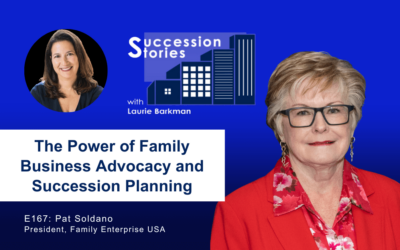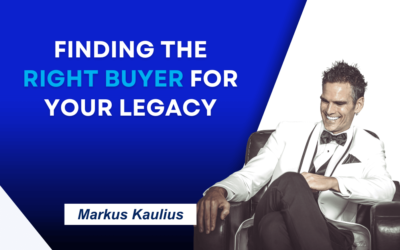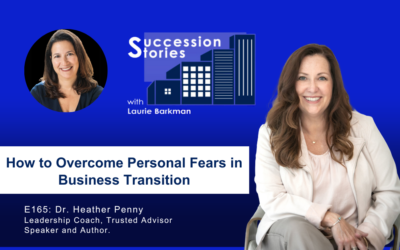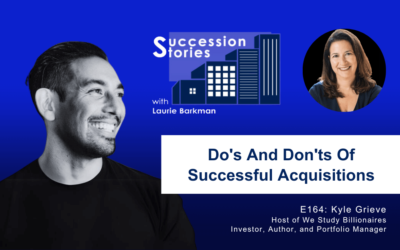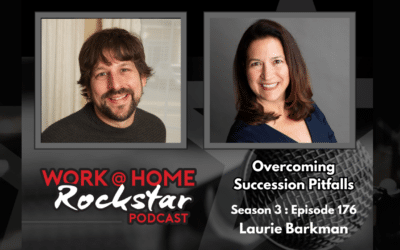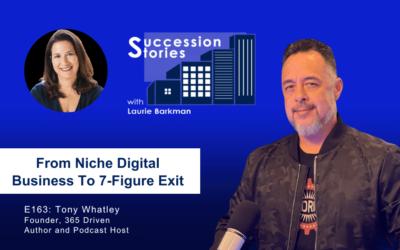“If a third party sale is in your future, why not set it up for success and then work backwards” – Laurie Barkman
Laurie joins host Jeffrey Feldberg on the Deep Wealth Podcast where you learn how to extract your business and personal Deep Wealth.
Listen to the episode:
80% of business owners want to stop working in their business in the next 5-10 years, but most have not planned for that transition. Many need to improve the business first.
Laurie Barkman is a “business transition sherpa.” With her firm, SmallDotBig, she advises owners on having more valuable, sellable businesses. And as a Partner with Stony Hill Advisors, a mergers and acquisitions firm, she guides them through the complex process of letting it go.
Laurie is the former CEO of a $100 million revenue company with an exit to a Fortune 50 company. With more than 25 years of C-Suite and award- winning marketing expertise, she provides actionable perspectives to drive sustainable value.
Engaging audiences across the US, Laurie is an Adjunct Professor of Entrepreneurship at Carnegie Mellon University, leads executive workshops with Vistage, and hosts a weekly podcast called Succession Stories.
Laurie earned her MBA from Carnegie Mellon and BS from Cornell University. She is a Certified Value Builder Advisor and has a Certificate from the Exit Planning Institute.
SELECTED LINKS FOR THIS EPISODE
Laurie Barkman (@LaurieBarkman) / Twitter
Schedule a Business Transition Advisory Call with Laurie Barkman
Laurie Barkman, The Business Transition Sherpa – YouTube
Succession Planning Stories Podcast SmallDotBig
The Deep Wealth Sell My Business Podcast
Transcript
[00:00:00] Jeffrey Feldberg: Welcome to the Deep Wealth Podcast where you learn how to extract your business and personal Deep Wealth.
I’m your host Jeffrey Feldberg.
This podcast is brought to you by Deep Wealth and the 90-day Deep Wealth Experience.
When it comes to your business deep wealth, your exit or liquidity event is the most important financial decision of your life.
But unfortunately, up to 90% of liquidity events fail. Think about all that time and your hard earned money wasted.
Of the quote unquote “successful” liquidity events, most business owners leave 50% to over 100% of the deal value in the buyer’s pocket and don’t even know it.
I should know. I said “no” to a seven-figure offer. And “yes” to mastering the art and the science of a liquidity event. Two years later, I said “yes” to a different buyer with a nine figure deal.
Are you thinking about an exit or liquidity event?
Don’t become a statistic and make the fatal mistake of believing the skills that built your business are the same ones to sell it.
After all, how can you master something you’ve never done before?
Let the 90-day Deep Wealth Experience and the 9-step roadmap of preparation help you capture the best deal instead of any deal.
At the end of this episode, take a moment and hear from business owners like you, who went through the Deep Wealth Experience.
80% of business owners want to stop working in their business in the next five to 10 years, but most of the plan for that transition. Many need to improve their businesses first. Laurie Barkman is a business transition sherpa with her firm, SmallDotBIg, she advises owners on having more valuable, sellable businesses. And as a partner with Stony Hill Advisors, a mergers and acquisitions firm she guides him through the complex process of letting it go.
Laurie is the former CEO of a $100 million dollar revenue company with an exit to a Fortune 50 company. With more than 25 years of C-suite and award-winning marketing expertise, she provides actionable perspectives to drive sustainable value.
Engaging audiences across the US. Laurie is an adjunct professor of entrepreneurship at Carnegie Mellon University, leads executive workshops with Vistige and hosts, a weekly podcast called Succession Stories.
Laurie earned her MBA from Carnegie Mellon and BS from Cornell University. She is a Certified Value Builder Advisor and has a certificate from the Exit Planning Institute.
Welcome to the Deep Wealth Podcast. And for all you listeners out there as usual, I have a terrific episode lined up, but this episode is gonna knock you off your feet. We have a fellow podcaster, thought leader. Someone who’s done a very successful liquidity exit is in the trenches and now helps other business owners achieve their life goals and dreams. So hang onto your hats. You’re in for a wild but fun ride today. Laurie, welcome to the Deep Wealth Podcast, an absolute pleasure to have you with us. And you know, Laurie I’m curious, there’s always a story behind the story.
What’s your story? What got you to where you are today?
[00:03:28] Laurie Barkman: Jeffrey, thank you so much for having me. I’m excited to be here with you. The story behind the story, let’s start with the name of my firm because that’s usuallya fun one. The name of the firm is small dot big and the story goes, I was playing pool with someone from Australia. Have you ever played pool with someone from Australia?
The answer usually is no. And the reason why it’s interesting is because they don’t say solids and stripes, they say small dot or big dot. And so for me, when I was thinking about my entrepreneurial journey, going out on my own, creating a firm, I picked that name because what is it ultimately that made me think twice about it gave me a different perspective.
It broadened my horizons and that’s essentially what I’m looking to do. And working with business owners help them see what they’re not seeing. So that’s my very quick little bit of an origin story on small dot big, but the full rewind is I’ve got 25 plus years in business, not from startups to fortune 500 and things in between.
I was hired from the outside to work with the owner of a third generation business. The chairman at that time was in the sixties and third generation. So the company was you know, a hundred or so years old. And we had, as you mentioned in the introduction, the liquidity event, the company was sold for over a billion dollars. And it was a very exciting time. And going through that M and A process was really interesting. It was challenging. And we could talk all day about that. That’s probably its own episode, but nonetheless, I’ll only have positive things to say about it. And what it did was it got me on this journey to wanna be on the deal side of things.
So after leaving the corporate position with the new owners, I won’t go into the details of all the transaction, but it was a publicly traded company and I was an officer of the company and it became a really exciting role, but like many things, they have their own transitions.
And so when I left the business, I went into private equity and I was on the other side of doing deals. And I really got into kind of being a deal junkie. And that brings me to where I am today. So that side of it is I’m doing mergers and acquisitions work. I’m working with business owners to help them have successful transitions, creating value, and then benefiting by letting the company go on their terms.
[00:05:56] Jeffrey Feldberg: Wow, Laurie so much to unpack there, but first things first, come on only 1 billion dollars, really? You gotta come on, you gotta work on that. We gotta get them a little bit bigger than that, Laurie.
[00:06:05] Laurie Barkman: A little bit bigger. Get bigger. Yeah.
[00:06:07] Jeffrey Feldberg: Wow. A billion dollars. That is absolutely incredible. Just let me ask you something about that, because we hear this all the time from advisors they’ll often say particularly investment bankers, you know what, whether it’s a $10 million transaction it’s just some bigger numbers, but the process is more or less the same. A little bit more time up or down, but not much changes. What did you find looking back now that you’ve done the billion dollar liquidity event, and now you’ve done everything else in between.
[00:06:33] Laurie Barkman: Yeah. And just to be clear, my piece of the business was a smaller piece. This was definitely a team effort. And what was interesting about it? Our business was at the time the whole company was doing over a billion in revenue, just on its own, standalone.
So the deal was a pretty big deal. But again, we were a fairly sizable business. The total company was a pretty sizable business and the acquirer came knocking. And so I think lesson number one was how can you really be ready when you have no idea? cause this acquirer is looking at you. They were looking at us from afar for about six years.
They told us we had no idea, but when they came in knocking, it was very interesting and compelling. This was a company that had a playbook. They have a corporate development process. They do very large deals and they have a definite way about it.
So I think from our side, I was part of the management team. We were about 12 people, and then it grew from there in terms of who knew about it. There was a very tight, very confidential situation, but yet at the same time, we needed to run our day-to-day businesses and not mess anything up. And we all knew that was really important.
So I think for business owners that are in that situation where you don’t have a team of 40 people working on this from the inside, trying to support the data room, build up the data room and providing all the questions and answers and thinking about all the things that are that we need to do.
We had some folks that were supporting us from outside, but then largely inside. And at the same time, we were told, hey, keep running your day to day business. So I have a lot of empathy for business owners that are trying to do this on their own. I think that’s regardless of big company, small company, you’re gonna run into that.
[00:08:14] Jeffrey Feldberg: Wow. And so it sounds like from that one liquidity event, you had some terrific takeaways that you’ve now I presume you’ve applied to your practice. Is there, you know, a top one or two takeaways that you can share with us that you took and you’ve now just woven into your best practices or your strategies?
[00:08:32] Laurie Barkman: I think the main thing is if you’re looking to get acquired, having the right fit, what pain points are you solving for the acquirer? Why do they want to buy you? It’s a build by or partner type of decision. And I think the main conversation that they’re having the acquirer is looking at you and when you’re not in the room, those are the things they’re gonna be talking about.
And so I think one is having that recognition of what makes you different, special, unique. What is additive? If you’re a small business, you might be really small. You might have really high caliber of talent. You could have a team of three people and be interesting to and acquire because they don’t have the skill sets that you have.
And so it’s an acquihire situation. And in this situation we were in was they didn’t have the services that we provided. They wanted to bolt that in and creating that from scratch. Would’ve been very difficult. So I think that’s probably the number one thing is understanding if you’re the seller and you’re envisioning having a Exit to a third party at one point in the future, can you look forward and think about that narrative?
You know, What’s the narrative and you might find that if you work backwards, you might change your product service mix to better fit potential acquirers in the future.
[00:09:56] Jeffrey Feldberg: Yeah, I love that because obviously for us at Deep Wealth preparations are wheelhouse and for us preparation is the gift that keeps on giving in. Laurie you’re absolutely right. And part of what you’re talking about in our nine-step roadmap, is step number three, where you’re mastering the art and signs of thinking like a future buyer.
And what you said for the listeners is just so valuable. Not that we necessarily know who the future buyer is going to be. Chances are we’re not going to, and it’s not really our responsibility to find the future buyer. We’re gonna leave that to an investment banker. But like you said, if you said well, you know, I’m gonna wave the magic wand, who would likely be an acquirer and then you figure out, okay, what are their pain points? How do I fit in? You know what, maybe I can do some of these things to solve the problems I’m not doing right now. But let me get into that. And lo and behold, you never know where that goes. I just love how you’re thinking forward that you can bring it back to present data, really make a difference.
But let me ask you something. You know what you’re known as a business transition Sherpa. And when I was reading that about you and just going into your background, I was like, oh wow. What an interesting term. And I’m sure there’s an interesting story behind that. So what’s going on with that?
[00:11:03] Laurie Barkman: I find that my skillset, one of the things I bring is clarity and I hold myself and my clients accountable to a plan that we develop and finding that clarity. Holding ourselves to a process. That’s what a Sherpa does. And lifting things on our back. So I like to say, look, I don’t have all the answers I ask really good questions, and my job, again, back to the small dot big and helping you think differently about something, helping you see something you’re not seeing.
So if today we ask ourselves what’s our business worth many times the answer is I have no idea. We gotta start somewhere. So where do we start? How do we map out where we’re headed and then how do we get there? So that’s the Sherpa idea. Years ago, I was in Nepal with my husband and yes, we had a Sherpa.
We didn’t climb out Everest, but we did go up on this amazing four or five day track. And my description is it’s like doing the StairMaster for seven hours a day. Literally, we’re just going up up. And our goal was to climb above the clouds and see the sixth highest mountain, the mountain in that range and indeed we did. We got lucky with that, but having a Sherpa, having somebody who carried my backpack, that experience will stay with me forever.
[00:12:11] Jeffrey Feldberg: Absolutely. And as we’re talking a little bit offline, And this is our favorite rhetorical question for business owners, the skills that built the business, aren’t the same ones to sell it. So when you think about it, from that perspective, how in the world, can you master something on your own that you’ve never done before?
And of course on your own, you really can’t. If you have one chance to get it right, this is where you wanna have someone like yourself to come along and make the difference. And so Laurie, I’m gonna ask a bit of a general question and you’re probably gonna say Jeffrey, it depends on the business and what’s going on, but bear with me on that.
And the questions this, let’s follow Pereto’s Law where 80% of the businesses are having a problem that comes from 20% of the same issues that are just taking place again and again, in the businesses, when you’re on board with a business and you’re gonna help them from start to finish to really get things in order and then have a successful liquidity event. What are some of the common skeletons in the closet as we call them or blind spots that you can share with our listeners today that coming out of this episode, they can say, oh, okay. Laurie said this, let me just see if that applies to us.
And if it does, I’m gonna make sure that we correct it.
[00:13:16] Laurie Barkman: Yeah, the trip wires and finding those trip, wires are really important. I think the number one thing would be financials. If your financials are not in order. That’s a great place to start. QuickBooks is fine. I’m not saying everybody needs to go get audited financials, but having consistent way of measuring and tracking your financials again, using QuickBooks and being consistent with it, being accurate with it super important, knowing what your expenses are that might be personal people don’t always wanna share, cuz they’re worried. Oh no, the tax fan’s gonna find out. That’s not really what we’re all about. And it’s not necessarily down to the penny, but if we can do a financial analysis and on areas that we call addbacks. So addbacks are non-cash things addback are one-time revenue that would not repeat.
They might be one-time expenses that might not repeat. They might be the business owners expenses that a new owner would not continue forward. And so we need, if we’re doing evaluation and I’m a certified I don’t know if we mentioned this in my description of myself, but for me, and getting my certification as a Mergers and Acquisitions Advisor, I found it really important to understand the mechanics of how valuations work. There’s an art and a science to it. And so Jeffrey, you might say how is value attributed to a privately held company? The answer is infinite. Any buyer in the private market can attribute a value that they feel is the most right story. Even you, that you shared about, you had an offer for seven figures and you had an offer for nine figures.
And in that time change, and in that dynamic of that buyer, with the nine-figure offer, they saw something in your business that was important to them and they justified it internally. So that’s the magic of all of this, but the financials is a great place to start because that so many times that’s where organizations might not have their ducks in a row.
[00:15:22] Jeffrey Feldberg: And you know what, it’s such an important point, Laurie, that you bring home. And we talk a lot about this in the Deep Wealth community. You’re calling them addbacks. We call them EBITDA adjustments, but they’re really one in the same. And what we like to tell business owners and for the listeners, please listen up stop what you’re doing right now.
And listen to this because you don’t wanna really give your future buyer a choice. You don’t wanna show up to your future buyer and say, you know what, all these expenses that are here well, you don’t really need them to run the business. That’s just my lifestyle. I have tickets to my favorite sports team or to the opera or here or there, or I like over buying inventory because it just makes me feel better.
Ideally, and it makes your company more profitable and yes, you’re gonna be having higher taxes, but it’s really a rounding error relative to the return on investment that you’ll get from the liquidity event. What we like to suggest is if you can remove those add backs and have a good year minimum or two or even three years.
So you’re showing up to the future buyer saying, okay, here it is no explanations. There’s nothing to challenge. And you’re just the better off for it. Thoughts about that?
[00:16:22] Laurie Barkman: That’s a legitimate, good piece of advice and some organizations can do that. And some can’t, there’s some clients that I’ve talked to. I should say prospects, even that they’re not a client because of this reason they have a service business and a product business, and they wanted to separate and sell the service business. Or separate and sell the product business, but the financials are intertwined. So how would any prospective buyer be able to understand what they’re buying if you can’t show them differently? And you can’t show a P and L and he said let’s just show the revenue. Okay. But it’s not really the full picture.
[00:17:01] Jeffrey Feldberg: Absolutely. And, you know, Laurie, let’s circle back to something else. You mentioned it during our discussion. And I know in your background, this is a really big piece of what you do. It’s clarity. And oftentimes for business owners, they are the business. The business is them. Everything’s in really this one kind of muddled picture with them. They really can’t see the trees from the forest as the saying goes or something along those lines. So how do you bring clarity to business owners when you’re coming in? And they’re saying, hey, Laurie, you know what? My financial future is in the balance here. Can you please help me? I wanna start the next chapter of my life, but I have no idea how to do that in terms of having some kind of liquidity event or Exit for the business.
[00:17:43] Laurie Barkman: Yeah. It’s like holding a mirror up to yourself and someone saying that maybe you need a haircut, right? It’s sometimes very challenging to hear from someone objectively what you might be facing. It’s not all rosy. And I do have some clients right now that are in that situation. They’d love to sell their business for some magic number.
And then we go to the reality of where are they today. And then what’s their timeline? And if their timeline’s fairly short, let’s say two years or a year. And there really isn’t a lot of time to make an impact and a lot of changes, then they’re stuck. And that’s, it’s a tough place to be, you know? and that reality check. So how do I do that with clients? Well, I have a couple of different assessment tools that we use to help objectively paint that picture of where are they today. And when I say they, three things, one is their business. We do a business assessment and I’ll invite the listeners to follow up with me for that business assessment.
I’m happy to go through that with them. And also the personal assessment is something if they wanted to follow up with me about that. But nonetheless, both of these assessments are really critical. What we’re trying to assess is the strengths, the opportunities. And again, some of these trip wires, what are they not seeing?
And we measure on a couple of different dimensions. I’m a value builder Advisor. And I use this platform called a value builder system and thousands of business owners have gone through the questionnaire. And in my practice, what I focus on is not only their absolute number and how they’re scoring in the red, yellow, or green, but also then how they compare in their industry versus their peer group.
And so are they on track? Are they off track in and of themselves? And then how are they comparing the peer? So I think that data is really important and insightful. And then on the personal side, It’s the personal readiness and what things might be holding them back from visioning the future. We talk about pull factors and push factors.
What does that mean? If you’re excited about something, if you’re ready to go forward, maybe you’re looking forward to that vacation and you’re like, oh, I gotta get on that airplane. Or if you’re dreading that flight, oh, I’m so afraid of the flight. I gotta take my Vicodin or whatever, I can’t fly.
I get anxiety. How you feel about that trip? Is gonna be pretty different depending on that mindset. Imagine you’re headed into thinking about selling your business. I don’t know my name’s on the door. I’m the second generation my father founded it. I don’t know, I feel guilty about selling.
The emotion side, we can’t ignore the emotional side of all of this. So the personal readiness is definitely the emotional side, how you feel about things, but it’s also, what are you excited about in terms of your next steps. And there’s a whole lot here. I could again spend a whole hour talking about it.
This is where I start with people because we have to level set on where are they. And so when I have client onboarding, this can take two, three meetings because the questionnaires are probing them to think about things they haven’t thought about. And I’m getting them to write it down also. Which also is something maybe you come back to. So we’re establishing a foundation of personal readiness business readiness. And then the third element is the financial, what financial goals they may have. And then we put it all together to say what’s really realistic here. Let’s just say, you know, you wanna sell your business for 10 million, but your valuation at the outset is gonna look negative because your EBITDA has been negative the last three years. We have a major gap, and I’m exaggerating a little bit, but not much. This can happen. So people, have a vision of what they wanna sell for how they wanna have a lifestyle and they might need to fund that. But then their business is just one maybe piece of their total picture of net assets or assets.
So we need to look at that and ultimately try to work through. If time’s on your side, then you have time to work through these things. And so back to your original question, yeah. It’s really tricky situation when you really don’t have the time and you have that gap. And so that clarity of, oh boy, what are my options given where I am?
[00:21:58] Jeffrey Feldberg: Yeah, so powerful. When again, it all goes back to preparation. I know you’re exaggerating somewhat, but it’s not that much of an exaggeration. And can you imagine Laurie and I’m sure you’ve heard these stories? I’ve heard these stories. An owner goes through a liquidity event, sells the business.
So it’s done, it’s closed. It’s now in another buyer’s hands. And the original business owner is, oh my goodness. I didn’t realize taxes would be that they weren’t prepared. I don’t realize taxes would be that much. And my cost of living is greater. And wow. I don’t know if I’m gonna be able to support my lifestyle on a go-forward basis.
And it just creates a disaster of a situation and really they’re back to square one, maybe getting even a JOB as I call it to support themselves. That’s why preparation is so powerful. But let me ask you something. We were talking about some of the low-hanging fruits going into a liquidity event of what a business owner can do to prepare and very eloquently and gave some terrific advice of, Hey, look at your financial start there when you’re gonna be preparing.
And there’s a whole other list of things that you would do, but that was one of the items. Let’s look now on the flip side of that in the post Exit life. And I know for myself, my post Exit, as crazy as it sounds, that’s where I made my biggest mistakes and just stupid decisions because I wasn’t prepared and nothing leading into the liquidity event, nothing that I had read or that I had done or spoken to people really spoke about that.
And so I’d love to hear. What a business owner can do in your books when it comes to planning for the post Exit today, even though a liquidity event could be 10 years down the road.
[00:23:35] Laurie Barkman: This is a great question. This post Exit life ties to what I was saying earlier about the personal readiness. And you might say you’re starting with these questions, but that’s a post Exit situation. And exactly, that’s the point, because if I can work with business owners to help them envision their future, why do they wanna even have an Exit?
What are they caring about right now? What is their family caring about right now? Who are the relationships they have? They’re an important part of their life. Do they have relationships and an identity outside of the office? If the answer is no. We’ve gotta work on that. What I talk with people about is how do you see yourself.
Who are your important relationships? What identity do you have? So I have business owner identity. Okay, great. What outside of business might you have while I’m a father? I’m a son, I’m a great cousin, I’m a volunteer. What are all those things that describe you? That maybe you haven’t really thought about that helps shape your identity and things you care about.
How do you spend your time? Are you socializing? If you have a party, are you bringing, are you inviting everyone from the office or do you have a completely different friend network? So those types of things of how do you spend your time? What’s important to you and what might you do differently if you weren’t in the day, the JOB or, in this business day to day and taking all that time and even, you know, you could say to Jeffrey I don’t wanna sell my company.
I just wanna not be in it as much. I wanna be chairperson. I wanna put my feet up on the desk and spend less time on, I wanna own multiple businesses. Great. That’s all part of it too where, how do we create a scenario where you can live the lifestyle that you want? and balance everything.
So this post Exit life, the visioning part of it is really important. So it’s the relationships you have. It’s the identity for yourself? It’s not only the kind of the income, the lifestyle, some people say I’m going to need income, but I want it to be more passive. So I wanna start looking at maybe real estate. And doing real estate investments. And I see myself doing real estate investments and not necessarily, owning another company. Some people say, oh, I wanna start another business. Those are more of the mountain climber type of people who can just go get the next mountain. So this post Exit life, the more we can identify upfront the pre will help in the post.
[00:26:07] Jeffrey Feldberg: It is terrific. And you know what, the, really the three sides that you’re looking at, the business assessment that you’re doing, the personal, and then on the financial, it really sounds like big picture wise. You’re getting a sense as the business transition, Sherpa you’re getting a sense of, okay, what’s working here.
What’s not working here? So Laurie walk our listeners through, you’ve gone through that. Now you’ve gone through those assessments. It’s taken however many meetings, but you finally got it down. You’ve got the big picture going for you. What would happen next in your process as you work with a business owner?
And again, I know every business is different. Every owner is different. Generally speaking, though, what would that look like?
[00:26:43] Laurie Barkman: If an owner and I are talking and we are getting the understanding about different options, Exit options, and one of the top options that they have is for a third party sale. Then I typically recommend that I do a valuation for them, an official valuation. It’s not a certified valuation, but I use the word official meaning that we use different methodologies in as evaluation provider to do that and do an analysis for them.
So typically what we need for that is three years of financials, tax returns. We use tax returns. We use something that’s provided to us and we do the analysis. We do different comps, public companies, privately held company comparables and things like that to come up with the math. Now I know that math isn’t always something that gives us an answer.
We try to give a range of value and it’s the art and science of this, but it’s helpful to just know what ocean we’re swimming in. Cause again, if the owner wants to sell for 10 and the valuation comes back at five, we’ve got a gap. We’ve got a pretty big gap that part’s important all then if they are interested in proceeding to a sale process, we begin that process, which is we’ve gotta develop the narrative. We’ve gotta develop the marketing materials for bringing the company to market. So some of the acronyms or some of the business language, maybe you’ve talked about with others on the show a confidential information memorandum, the acronym is CIM, C I M.
We work on that. We work on a teaser. We’re getting your business again, ready for this external outreach. If we wanna run an auction process, we’ll put together the timeline. We’ll assemble the team. If you already have a team that you’ve worked with or know, for example, an M and A attorney, if you don’t, we’ve got our speed dial Rolodex and we can make introductions.
So we wanna assemble all the right people so that you’re truly ready. Financial Advisor is helpful. A certainly an accounting firm that has M and A experience can be very helpful when it comes to the tax assessments and things. So getting the team in place, getting the timeline, getting the business, ready to be marketed.
That’s the external stuff. The internal stuff is this creating this internal data room. So with clients, I’ll say, okay, here’s the list. This is what I need. And go back to the readiness topic, Jeffrey, where if they’re not really ready and they don’t. They don’t know where their operating agreement is.
Under fingertips, they don’t have these things that people say, oh how long do things take? It’s the getting ready side. It’s the pre M and A that can take while, but then if you’re really ready and someone says to you, here’s the checklist upload all this stuff to the secured data room and you say, okay, no problem.
That’s an ideal situation. So with some clients who say, I’m ready, If I’ve worked with them or someone else has worked with them to help get them ready. That’s great. Otherwise part of this process is helping them. Helping them get ready. So we’re kind of, you know, trying to steer the bus while we’re already on the highway.
But yeah, you know, it’s kind of a mixed bag with that. So ideally, we’re now ready to bring that company to market. We’re doing research. We might be doing invitations for companies, strategic companies to participate, or maybe private equity buyers to participate.
And we run an auction or we might be doing more outreach, that’s more in sequence. So we can design a process that makes sense for the seller. And that’s for one pathway. The other pathway is I’m really not ready. I wanna think this through, I got some work I need to do on my business.
I wanna work on some of the areas that will help me increase my value, reduce my risk, make my business more transferable. And then what I do is I work with them in a coaching capacity advisory capacity on a monthly basis, we meet a couple times a month and we’re on a I’m helping to hold them accountable to a big picture plan that helps get them ready.
And when they’re ready for that crossover to the transactional part, then of course, we go down that path that I just described.
[00:30:50] Jeffrey Feldberg: What a terrific description really on both sides of it and for our listeners out there, what Laurie’s talking about, it’s so easy to miss as a business owner, because here’s the deal. If most business owners, which is what they do, they just show up one day and they say, okay, Mr and Miss Investment Banker I’m ready.
Let’s go to market. Congratulations. You now have a second full-time job. It’s called a liquidity event. You’re gonna be asked to do all kinds of crazy things while running the business full-time. Including projections, some of which will happen during the liquidity event. So talk about being under the microscope and more times than not Laurie, what we’ve seen are business owners they just give up their health, their money, and their time because they’re not ready.
And so Laurie, what’s here today that’s staying that perhaps three years ago, two years ago, five years ago, wasn’t here.
Any thoughts on that?
[00:31:37] Laurie Barkman: Well, Private equity is going. The shifts in terms of their approach. So I can’t project to the future. You know how if that’ll continue, but certainly the trend with private equity has been to do anchor investments where they’ll do a large investment. They’ll probably pay more for that transaction that you might have seen in the past.
There was a good availability of money to be borrowed at a decent interest rate. So whether or not that’ll continue in the future, we’ll have to see but that trend of doing a anchor investment and then doing tuck-ins I think, as a strategy. We’ll probably continue. So the opportunity is that smaller firms who might not have gotten the attention in the past might get so now, because they’re, quote-unquote more affordable.
And I think the numbers from a private equity standpoint, there’s still a lot of dry powder out there from invested capital from partners that needs to be deployed. So the timeline for PE to get typical time horizon five to seven years, that will maybe that’ll lengthen, who knows. But I don’t really see that dynamic changing too much.
On the strategic buyer side there’s probably some impact from what we’re gonna be with all the headwinds from the economic downturn, there might be some belt tightening and perhaps that market might start to slow down. And I don’t know, I can’t pontificate too much about it because it’s very variable as you know, but I think for business owners who are looking for a liquidity event the ESOP option, if you’re big enough, can still be a good option.
It still has the tax benefit, a typical ESOP. A deal will be, I think, a minimum of around 2 million in EBITDA. So it’s not for every company you have to be. Has to justify itself because you do have expenses and some maintenance of that of that new ownership arrangement. But for some companies it’s an excellent option.
And I think the other thing that will continue is the development of family and offices as an investor group. The other trend for entrepreneurship, acquisition of entrepreneurs. I also think that trend will continue where either individuals who are looking to buy businesses or joining together in syndicates.
So they’re a PE group, but not that’s like this unknown group of potential buyers that are out there. There’s many of them. And by the way, on the other side of this, as I just mentioned with family offices if your audience isn’t familiar, typically family offices are really under the radar.
These might be families that had a liquidity event and they’re looking to do investments maybe it’s institutional money. They put it into various things. Sometimes, now they are looking to almost look like a PE group. So they are buying companies themselves. I think that is going to be more of a trend.
And there are, I’ve seen different numbers, but up around 30,000 family offices in the US.
[00:34:49] Jeffrey Feldberg: Yeah. It’s interesting. And first and for our listeners will take a quick step back. If you’re wondering ESOP, what is that a new word? I haven’t heard that before. It’s an Employee Stock Option Plan, and this is where the employees are potentially the future owner of the company, depending on what’s going on.
And Laurie, let me ask you this, big picture wise for our listeners and from your experience, you’re in the trenches, you’re on both the preparation side and then going to market on the liquidity event side. If there was, a top one or two things, generally speaking, that listeners could walk away with today of saying, okay, I wanna be successful statistic, not a negative statistic. I want to increase my enterprise value. I want to increase deal certainty. Is there something that you can share as a good proven strategy or two that they can start implementing, or at least look into coming outta this episode?
[00:35:42] Laurie Barkman: I would say the first thing is to have an idea of what your goals are and if goals are in your head, that’s great. Write them down. The more you write things down, the more likely you are to achieve them. So let’s articulate what your goals are. And if your goal is to sell your company for X dollars amount in five years, write it down, whatever your goal is, maybe your goal is to transition your company to the next generation, really, successfully.
That’s great. And I don’t, cuz I don’t presume that the answer is always to sell the business, by the way, I like to say that let’s come up with a transition plan. And if that Exit is to a third party, that’s great. Otherwise, there’s lots of other options. So let’s be clear about what we’re trying to accomplish and why, and let’s come up with options because maybe the first option, isn’t always the go-to.
For some reason, we get derailed. We need another option. If we only put all our eggs on one basket. Sometimes that can be a problem. Oh, I think that my second in command is gonna buy my business from me one day. What happens when that second in command leaves? Oh, I have no other options.
Okay. That’s a problem. Let’s broaden out and come up with prioritization of what we’re thinking. So it’s the AC, it’s your goals? What are you trying to accomplish and why, and what are some of these Exit options? And if we think that selling to a third party is our first priority. Let’s spend some time thinking forward.
So if we to quote Steven Covey begin with the end in mind and work backwards, there’s a, an excellent example of this of a gentleman who was on my show is called Succession Stories. And Jeffrey like you as a podcaster, I love talking to people about their experiences, cuz I learned so much from them and the audience does too.
And in this particular episode, the entrepreneur on his own, he didn’t have an Advisor. He just intuitively knew that this was something he should do. And he was successful at it. He spent more than six years. Talking to strategics talking to financial buyers, PE groups and building relationships. Now, why did he do that?
He did that because David Weibel is his name. So David successfully sold his company eventually, but in the time period that he was doing the research, he learned that the potential acquirers were more interested in his business. If it had a recurring revenue. Business model at the time, it did not.
So what did he do? He decided to change the business model and it was not easy. It was painful and it took years to get there. And I think ultimately, and I think he shared with me, he maybe got to 30 or 40% of his revenue was recurring. It wasn’t a hundred percent, but it was more than zero, which is when he had started that research and figured out, oh, wow.
If I wanna sell to this type of buyer, they’re not going to be interested in me. Now time was on his side and he’s a good leader and he was able to make that pivot and it was successful. So I think that’s big thing. Number two is, can you think ahead again, if you’re interested in selling to a third party, if you’re interested in passing it to the next generation, make sure it’s a well run business that someone wants to take over.
And we could have a whole other conversation about succession there, but If a third party sales in your future, why not set it up for success and then work backwards to, if you need to make changes times on your side, you can do that.
[00:39:11] Jeffrey Feldberg: Terrific advice, write your goals down, think forward, work backwards, and that will serve you very well. And I think those are terrific best practices and strategies that every listener can take from this episode and start applying today. So, Laurie, you know what we could just go on and on, and you’re absolutely right.
Some of these topics not only are episodes, it could be an entire series on just some of these topics, but let’s do this as we start to wrap up, I’d like to have a little bit of a thought experiment with you. And I really have the, both the privilege and the pleasure of asking every guest, this question on the Deep Wealth podcast.
So here it is, I’d like you to think about the movie Back to the Future. And in the movie, you have that magical DeLorean car that can take you back to any point in time. So Laurie, imagine now it’s tomorrow morning, you look outside your window and not only is the DeLorean car there, but the door is open. It’s waiting for you to hop on it and you can now go to any point in your life.
Maybe it’s Laurie as. A young child or a teenager, or in your early adult years, whatever point in time it would be. What are you telling your younger self in terms of, Hey Laurie, here’s some life wisdom or lessons learned or Laurie do this, but don’t do that. What would that sound like?
[00:40:25] Laurie Barkman: When I was graduating from getting my MBA, it was very fashionable. If I can use that word for entrepreneurship to equate to a tech company that needed to have something really exciting and you go get venture capital and go all in and you just can have the big idea and you raise money.
And while it sounded exciting to me, I knew it wasn’t my path because my risk profile just didn’t. And I didn’t have a big idea and I’m not a tech person. I’m more of a marketing person, business development person, what have you. And so that just didn’t come forward for me. And so for years I felt like I wanna be entrepreneurial, but I’m not that.
And there wasn’t another option. So I think if I had my DeLorean and went back in time, I probably would’ve bought a business. I would’ve bought an existing business and be an acquisition entrepreneur. I don’t really think I knew about that as an option back then. And I’m talking like 1999, which was the dot com bubble.
And everybody was still very excited about what’s happening in this new tech environment. And it was all about, create this sexy startup, but a company that has positive EBITDA and cash flow is very exciting too and can lead to a nice lifestyle and other options to, from an entrepreneurial standpoint.
And so that other flavor of entrepreneurship, I just didn’t have exposure to at the time.
[00:41:53] Jeffrey Feldberg: You know what great advice of, hey, don’t get too cut up in whatever the latest trend of the day is because it’s here today, gone tomorrow. And for our listeners really leveraging from the heavy lifting that you’ve done since of, hey, look around what talks you, what resonates with you? What are your strengths?
I think that’s a terrific takeaway for everyone. Well, Laurie, we’re gonna wrap up this episode officialy. if somebody would like to find you online and reach out or ask questions, what would be the best way to do this? And I preface that by saying for our listeners, everything’s gonna be in the show notes. So you don’t have to worry about pulling over or writing this down or remembering it’ll be a point and click.
It can’t be any easier. So, Laurie, where would that be? What would that look like?
[00:42:31] Laurie Barkman: The number one thing, which is hopefully easy to remember is meetlauriebarkman.com. So they can go there and set up a time to meet with me. And I’ll talk with them about this business assessment that I mentioned, and they’ll get not only the time with me and hopefully that’s valuable and not itself, but this business assessment I think, is really eye opening.
I’m happy to invite people for that. And then if to learn about me more generally, my website is smalldotbig.com, and there’s all kinds of goodies on that website, including my podcast. And you’re, if you’re interested in the show, it’s in all the platforms, it’s called Succession Stories. We’re also on YouTube and I’d love for your listeners to listen and check it out.
[00:43:11] Jeffrey Feldberg: Terrific. And again, we’ll have all those links and the show notes can’t get any easier. Laurie, thank you so much for coming on the default podcast, taking part of your day, ensuring both your insights and wisdom. And as you wrap this up as always, please stay healthy and safe.
[00:43:24] Laurie Barkman: Thanks so much, Jeffrey. I really enjoyed it.

